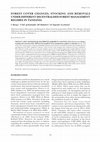Papers by Rogers Malimbwi

By the end of the last century many countries including Tanzania moved from centralised towards d... more By the end of the last century many countries including Tanzania moved from centralised towards decentralised forest management but little empirical evidence exists on how such changes have influenced forest conditions. The objective of this study was to provide insights on how decentralised approaches might influence forest resource conditions. Forest cover analyses from satellite images (1993, 2000 and 2009) and systematic sample plot inventories (2009) in two state forest reserves under joint forest management (JFM) and two village forest reserves under community-based forest management (CBFM) in Babati District, Tanzania were carried out. Based on the results, it was not possible to claim that the decentralised management had been successful in improving forest conditions. Proportions of closed woodland decreased significantly over time (from over 80 to 50-60% under JFM and from around 70 to almost 0% under CBFM. In all forests, numbers of regenerants were high, but proportions of larger trees were low and levels of removals (legal and illegal) were relatively high. In general the situation under JFM was better than under CBFM. Results of this study can be used by policymakers to assess the influence of decentralised forest management in Tanzania.

Carbon balance and management, 2015
REDD+ implementation requires establishment of a system for measuring, reporting and verification... more REDD+ implementation requires establishment of a system for measuring, reporting and verification (MRV) of forest carbon changes. A challenge for MRV is the lack of satellite based methods that can track not only deforestation, but also degradation and forest growth, as well as a lack of historical data that can serve as a basis for a reference emission level. Working in a miombo woodland in Tanzania, we here aim at demonstrating a novel 3D satellite approach based on interferometric processing of radar imagery (InSAR). Forest carbon changes are derived from changes in the forest canopy height obtained from InSAR, i.e. decreases represent carbon loss from logging and increases represent carbon sequestration through forest growth. We fitted a model of above-ground biomass (AGB) against InSAR height, and used this to convert height changes to biomass and carbon changes. The relationship between AGB and InSAR height was weak, as the individual plots were widely scattered around the mod...

Nature Climate Change, 2011
1 . REDD+ has potential to simultaneously deliver cost-effective climate change mitigation and hu... more 1 . REDD+ has potential to simultaneously deliver cost-effective climate change mitigation and human development 2-5 . However, most REDD+ analysis has used coarse-scale data, overlooked important opportunity costs to tropical forest users 4,5 and failed to consider how to best invest funds to limit leakage, that is, merely displacing deforestation 6 . Here we examine these issues for Tanzania, a REDD+ country, by comparing district-scale carbon losses from deforestation with the opportunity costs of carbon conservation. Opportunity costs are estimated as rents from both agriculture and charcoal production (the most important proximate causes of regional forest conversion 7-9 ). As an alternative we also calculate the implementation costs of alleviating the demand for forest conversion-thereby addressing the problem of leakage-by raising agricultural yields on existing cropland and increasing charcoal fuel-use efficiency. The implementation costs exceed the opportunity costs of carbon conservation (medians of US$6.50 versus US$3.90 per Mg CO 2 ), so effective REDD+ policies may cost more than simpler estimates suggest. However, even if agricultural yields are doubled, implementation is possible at the competitive price of

Wetlands Ecology and Management, 2015
A review of studies on belowground biomass (BGB) of mangroves revealed that procedures for excava... more A review of studies on belowground biomass (BGB) of mangroves revealed that procedures for excavation and determination of dry weight are insufficiently documented. The main objective of this study was therefore to describe procedures for quantification of tree BGB for Avicennia marina (Forssk.), Sonneratia alba J. Smith and Rhizophora mucronata Lam. The study covered four sites in Tanzania where 30 trees were sampled (10 for each species). A new root sampling procedure applied for A. marina and S. alba seemed to work adequately. Dry to fresh weight ratios (DF-ratios) varied between tree species, between tree sizes and between root components. Therefore, for each tree species, tree-and root component-specific DF-ratios were applied for dry weight determination. For A. marina and S. alba trees, a significant proportion of total tree BGB is stored in the root crown (34 and 10 % respectively). Future studies should therefore ensure inclusion of root crown when accounting for total tree BGB. Tests of previously developed models on our data revealed large prediction errors, partly due to differences in site conditions and partly due to incomprehensive excavation procedures applied when these models were developed. Local tree BGB models for mangroves should therefore be developed.

Forests, Trees and Livelihoods, 2012
Impacts of decentralised forest management on forest resource changes were assessed. Six contrast... more Impacts of decentralised forest management on forest resource changes were assessed. Six contrasting forest reserves regarding management regimes, that is, Joint Forest Management (JFM; in National Forest Reserves, owned by the State), Community Based Forest Management (CBFM; in village lands or general lands), and ordinary centralized state management, were selected. The forest resources were assessed by means of systematic sample plot inventories. Number of stems, basal area, volume, biomass, and carbon ha 21 were compared with results from previous studies in the same reserves. Harvesting activities were also assessed as part of the sample plot inventories. In general, the results were somewhat ambiguous regarding the impacts of different management regimes. There was, however, some empirical evidence indicating that JFM and CBFM performed better than the ordinary state management, although uncontrolled exploitation of the forest has continued under decentralised forest management in the studied forests. The two regimes are promising forest decentralisation models for Tanzania, but more research is needed to understand the functions of different governance structures and how they may facilitate sustainability in both forest use and livelihoods.
Forest Ecology and Management, 2013

Canadian Journal of Forest Research, 2014
Methods for constructing a sampling design for large area forest inventories are presented. The m... more Methods for constructing a sampling design for large area forest inventories are presented. The methods, data sets used, and the procedures are demonstrated in a real setting: constructing a sampling design for the first national forest inventory for Tanzania. The approach of the paper constructs a spatial model of forests, landscape, and land use. Sampling errors of the key parameters as well as the field measurement costs of the inventory were estimated using sampling simulation on data. Forests and land use often vary within a country or an area of interest, implying that stratified sampling is an efficient inventory design. Double sampling for stratification was taken for the statistical framework. The work was motivated by the approach used by The Food and Agriculture Organization of the United Nations (FAO) in supporting nations to establish forest inventories. The approach taken deviates significantly from the traditional FAO approaches, making it possible to calculate forest resource estimates at the subnational level without increasing the costs.
African Journal of Ecology, 2007

Carbon balance and management, 2015
Airborne laser scanning (ALS) has recently emerged as a promising tool to acquire auxiliary infor... more Airborne laser scanning (ALS) has recently emerged as a promising tool to acquire auxiliary information for improving aboveground biomass (AGB) estimation in sample-based forest inventories. Under design-based and model-assisted inferential frameworks, the estimation relies on a model that relates the auxiliary ALS metrics to AGB estimated on ground plots. The size of the field plots has been identified as one source of model uncertainty because of the so-called boundary effects which increases with decreasing plot size. Recent research in tropical forests has aimed to quantify the boundary effects on model prediction accuracy, but evidence of the consequences for the final AGB estimates is lacking. In this study we analyzed the effect of field plot size on model prediction accuracy and its implication when used in a model-assisted inferential framework. The results showed that the prediction accuracy of the model improved as the plot size increased. The adjusted R(2) increased from...







Uploads
Papers by Rogers Malimbwi